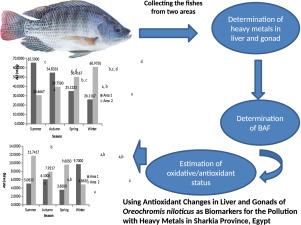Regional Studies in Marine Science ( IF 2.1 ) Pub Date : 2021-05-27 , DOI: 10.1016/j.rsma.2021.101863 Nahla S. El-Shenawy , Heba N. Gad EL-Hak , Mahi A. Ghobashy , Farida A. Mansour , Maha F.M. Soliman

|
The work was aimed to assess the heavy metals concentrations in the Sharkia Governorate, Egypt. The determination of heavy metal bioaccumulation and their antioxidant alterations on Oreochromis niloticus were considered. The gonads and the liver of the fishes were analyzed for essential metals (Cu, Mn, Fe & Zn) and non-essential metals (Pb) levels seasonally and their bioaccumulation factors. The results revealed that concentrations of the metals differ significantly between the gonads and the liver of the sampled fishes. During summer, liver bioaccumulation of the metals was in the order of Mn > Pb > Fe > Zn > Cu at area I and Mn> Pb> Zn> Fe > Cu at area II. However, the degree of tissue alterations in the gonads can accumulate the heavy metals in the following order Mn >Zn>Pb >Fe>Cu and Mn> Pb >Zn> Fe at the same season, for the areas I and II, respectively. The bioaccumulation of heavy metals in the liver tissue was higher than in the gonads of the O. niloticus. The antioxidant changes in the liver and gonads were mildly and moderately damaged, respectively. These indicated that Zn, Cd, Pb, and Fe polluted the Sharkia Governorate in the two selected areas. Elevation of lipid peroxidation in fishes was parallel with increasing the activity of endogenous antioxidants that could be to compensate for the stress.
中文翻译:

使用Oreochromis niloticus肝脏和性腺的抗氧化变化作为生物标志物评估埃及 Sharkia 省的重金属污染
这项工作旨在评估埃及 Sharkia 省的重金属浓度。Oreochromis niloticus重金属生物积累量及其抗氧化性变化的测定 被认为是。分析了鱼类的性腺和肝脏的季节性必需金属(Cu、Mn、Fe 和 Zn)和非必需金属 (Pb) 水平及其生物积累因子。结果表明,采样鱼的性腺和肝脏之间的金属浓度存在显着差异。在夏季,金属的肝脏生物富集在区域 I 的顺序为 Mn > Pb > Fe > Zn > Cu,在区域 II 的顺序为 Mn> Pb> Zn> Fe > Cu。然而,在同一季节,性腺组织改变的程度可以按以下顺序积累重金属:Mn>Zn>Pb>Fe>Cu和Mn>Pb>Zn>Fe,分别为I区和II区。肝脏组织中重金属的生物积累量高于尼罗罗非鱼的性腺. 肝脏和性腺的抗氧化变化分别受到轻度和中度损害。这表明 Zn、Cd、Pb 和 Fe 污染了两个选定区域的 Sharkia 省。鱼类脂质过氧化的升高与内源性抗氧化剂的活性增加平行,这些抗氧化剂可以补偿压力。











































 京公网安备 11010802027423号
京公网安备 11010802027423号